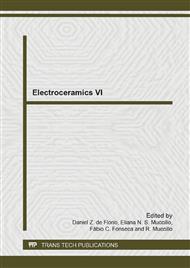p.201
p.207
p.213
p.219
p.224
p.233
p.238
p.243
p.248
Development of Novel Photoelectrode Materials with Improved Charge Separation Properties
Abstract:
This investigation was aimed at identifing the scope for exploiting segregation phenomena to improve the ability of doped TiO2 to separate photo-generated charge carriers. By applying several controlled conditions of temperature and oxygen activity during the annealing of Nb-doped TiO2 (0.65 at. %), compositional gradients were imposed within the surface and near-surface regions due to solute segregation. These compositional gradients were characterised using secondary ion mass spectrometry (SIMS) and Xray photoelectron spectroscopy (XPS), and then tested for charge separation abilities using surface photovoltage spectroscopy (SPS). This investigation has revealed that processing Nb-doped TiO2 under conditions that favour the depletion of Nb from the surface and near-surface region yields stronger charge separation. While this is attributed to the formation of a homo-junction that is providing additional driving force for charge separation, the altered impact of Nb5+ and related defect disorder may also play a role. This investigation has provided encouraging preliminary outcomes to stimulate further investigations.
Info:
Periodical:
Pages:
224-229
Citation:
Online since:
July 2014
Keywords:
Price:
Сopyright:
© 2014 Trans Tech Publications Ltd. All Rights Reserved
Share:
Citation:


